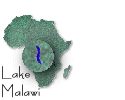| Cichlid Home.
Common Names.
Common Cichlid Knowledge.
Lakes Of Africa.
How To Set Up An Aquarium.
African Cichlids.
American Cichlids.
Catfish.
Common Diseases.
Guest Book And Poll.
Your Questions Answered.
Contact Us.
|
|
|
|
|
|
Lake Tanganyika
Lake Tanganyika
Lake Tanganyika is the biggest African Rift Lake in measures of water volume. The lake covers a total area space of 12,700 square miles and is 4700 feet deep. Lake Tanganyika has the most diverse form of aquatic life than any other African lake.
The pH in Lake Tanganyika varies in parts from 8.3 to 8.6 and has a temperature of around 25 degrees. Surprisingly the cichlids there have adapted to all the lakes areas. There is but a few places left where the fish cannot be found which is in the dark depths of the lake where the oxygen levels are too low for the fish to survive.
Large rock formations give homes for the Lakes Cichlids, such as Frontosa and Tropheus which these days are very common for the Cichlid hobbiest. Some of the lakes fish strangely take refuge in empty snail shells.
In the lake the fish feed on algae growths and small crustaceans.
The depths contain the genus Cyphotilapia which include the majestic frontosa, a fish very well known to aquarists.
Lamprologines are found almost everywhere in the lake and account for a huge part of the fish population.
Put in a cat fish and you would have a perfect Rift lake.
|
|
|
Lake Victoria
Lake Victoria is the second largest lake in the world. From shore to shore the total area span of the lake could easily cover the area of Ireland.
The Lakes water conditions vary greatly through the different areas of the lake. Fish from the area live in pH levels from 7.5 to 8.6. Cichlids from this lake are not as well known as cichlids from Lake Malawi and Tanganyika.
Unfortunately this lake is hugely under threat, due to actions of men. Most experts consider Lake Victoria’s future to be very bleak and bad. Over 400 species thrived there in the beginning but it is believed that less than half the original number of species exist today.
”Satellite Lakes” surrounding Lake Victoria are also home to some of the species of fish found in Lake Victoria. There is no doubt that more beautiful species of fish will be discovered as exploration of the Nile-Victorian continues.
As Cichlid aquarists we should take available Lake Victorian Cichlids as a blessing and should treat them with the upper most respect and worthiness. We should all try and keep the fish of Lake Victoria from becoming extinct.
|
 |
Lake Malawi
Lake Malawi is like Lake Tanganyika long, thin and very deep. It is the ninth largest lake in the world.
The pH levels in Lake Malawi vary much more than in Lake Tanganyika. Here the pH goes from 7.6 to around 8.6 which is slightly lower than that of Lake Tanganyika. Most water saturation occurs at the surface here, as in Tanganyika. In Lake Malawi there is less water breakage, so it makes it harder for the fish to breath so you will find most of then near the surface.
Most of the colorful fish known to hobbyists are found in rock structures along the shore. The fish in these parts are known to the locals as “Mbuana”(Rock fish). There are long stretches of sandy banks in Lake Malawi that are also home to many fish.
Cichlids of Lake Malawi are categorized into two groups.
The first, the being rock fish. These fish are very fast and like a spacious tank with a lot of rock structures. Fish take refuge in the caves and the males tend to defend them violently such as Melanchromis auratus (Golden Cichlid). Some of the fish in this category include Electric Yellow Labido, Tropheus and Golden Cichlid.
The second group of fish most common from Malawi are the Haplochromis type species. These include the popular Auratus. These fish are very differently shaped from rock fish. Haplochromis-like fish have a more vertical body shape, longer dorsal and pectoral fins, and are much more vertically compressed than rock fish. The brilliant colors are restricted to the males in Haplochromis species. Haplochromis are also fin eaters, where as rock fish are, mainly herbivores.
Most of these Cihlids can be mixed into one tank which in cause will make a brilliant show of colours. All Cichlids are alright too be fed flakes, however spirulina flakes or sticks are more preferred. This food can also help in the prevention of the disease Malawian bloat, which is common among Malawian Cichlids. This is caused by a blockage of food in the stomach.
In short, the many colorful creatures from Lake Malawi are truly amazing to own.
|
|
|


